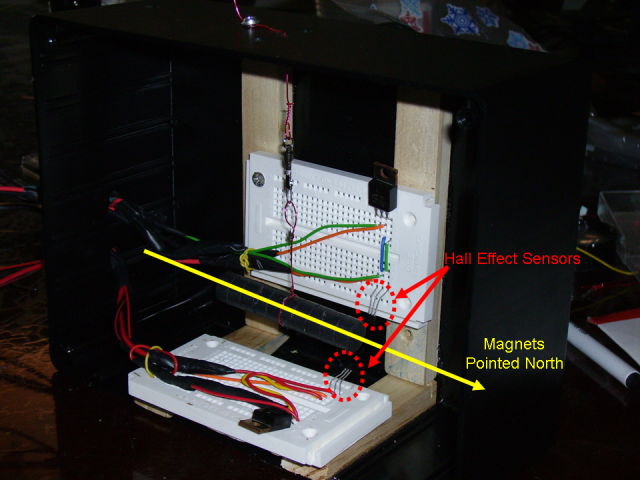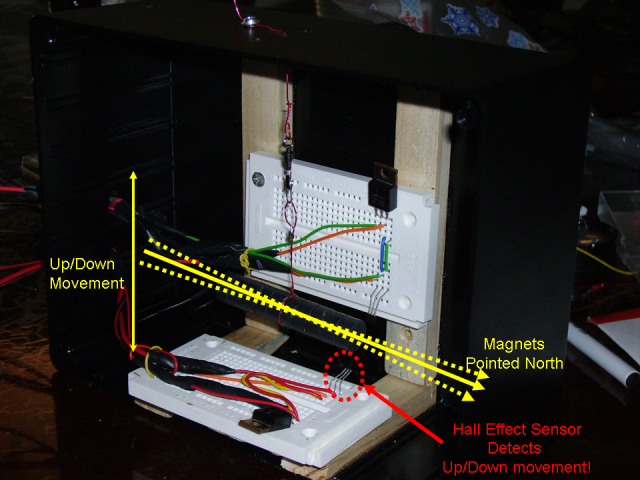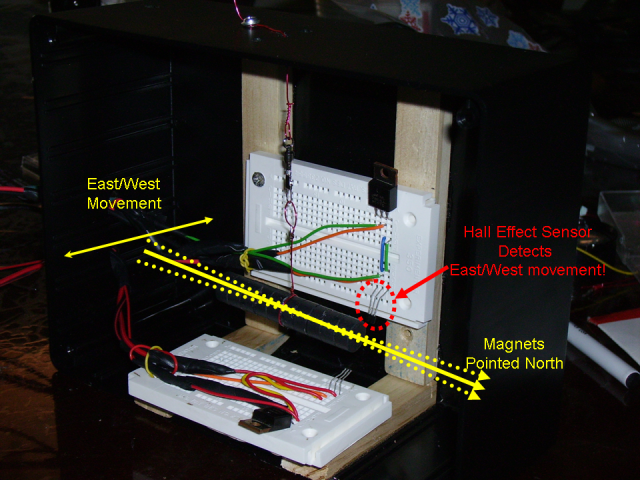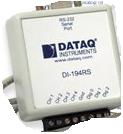
The
design uses two Hall Effect Sensors carefully placed a few millimeters
away from a cylinder shaped Magnet while the entire assembly is
oriented North so the magnetic cylinder is pointed north while
remaining a consistent distance away from the Hall Effect Sensors.
The Sensor is housed inside a small
acrylic box purchased from Radio Shack and wire Exfiltration holes are
penetrated on the side of the container. The Magnetic Cylinder is
suspended by a aluminum wire using a simple fishing swivel to reduce
overall resistance to the Earths magnetic field. I tried many differing
suspension models and the final, most effective position is to orient
the swivel as close to the Magnetic Cylinder as possible (not pictured!). This improved the "Up/Down" or "Z" angle movement freedom of the sensor.

The Hall Effect sensor is designed to be very
effective at determining movement/distance to metallic objects nearby
and we use this capability to our advantage. Our goal is to measure the
Earth's magnetic field flux (or field effect) as it gently moves the
freely suspended magnetic cylinder over several hours/days. Once our
sensor assembly is oriented north, the magnetic cylinder will
eventually come to rest in a north-south orientation as depicted above
and will only be moved by a magnetic field.
Here you can see the Sensor suite's basic principle of operation by positioning one hall effect sensor to measure the distance (or movement) of the suspended magnetic cylinder in an east/west direction and another hall effect circuit to measure the movement up/down.
The two sensors work together to
illustrate a very accurate measurement of the sensed cylinder's
movement ({"Z" or up/down} or {"H" or East/West} movement) caused
by magnetic fields acting upon the magnetic cylinder (hopefully
due to the Earth's Magnetic field effects!). We achieve this by
independently measuring the voltage of each Hall Effect Sensor's
Circuit voltage.
By using the
Hall Effect sensor to measure a very heavy, magnetic object, the
slightest movement should be detected.

It's CRITICAL to note that the Black, Acrylic
sensor container must be enclosed within another assembly of some type
to help reduce the undesired movement of the magnetic cylinder because
of Air pressure changes (wind) or Shock. After noting the shock
disturbances of large trucks driving down our street and air pressure
changes due to doors in the house opening/closing, I resorted to a dual
shock/air resistant
enclosure by placing the container above inside a 10 Gallon
Aquarium, with a floor of foam and shock resistant rubber... Which was
again sealed inside a 25 Gallon Aquarium with a similar base to reduce
Shock and Wind affects. This worked well once finally positioned
north and wind/shock no longer affected the experiment.
Hall Effect Sensor Output Data measurement was
accomplished by connecting the output of each of the two circuits to a
Dataq 194 Acquisition instrument which yielded very good output
(pictured below). Using Some Custom Software I was able to plot the following output (below).


